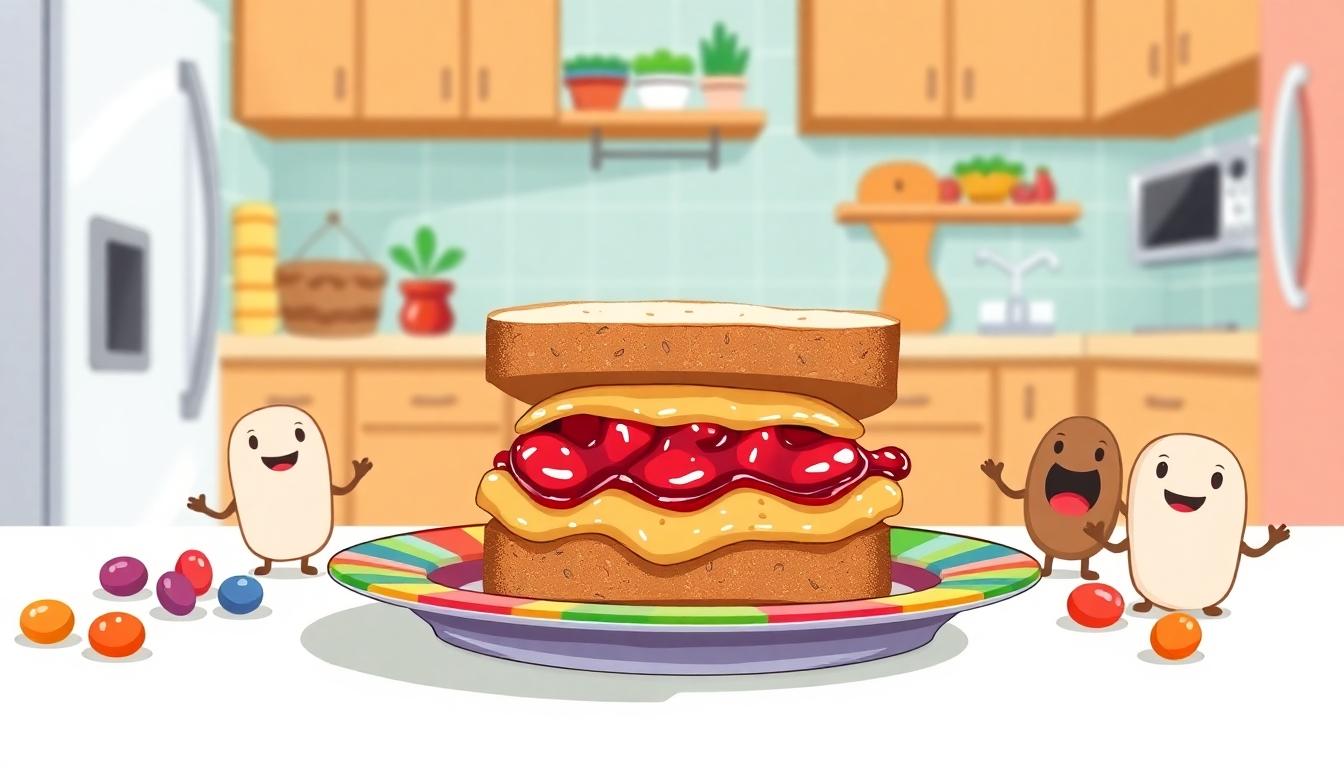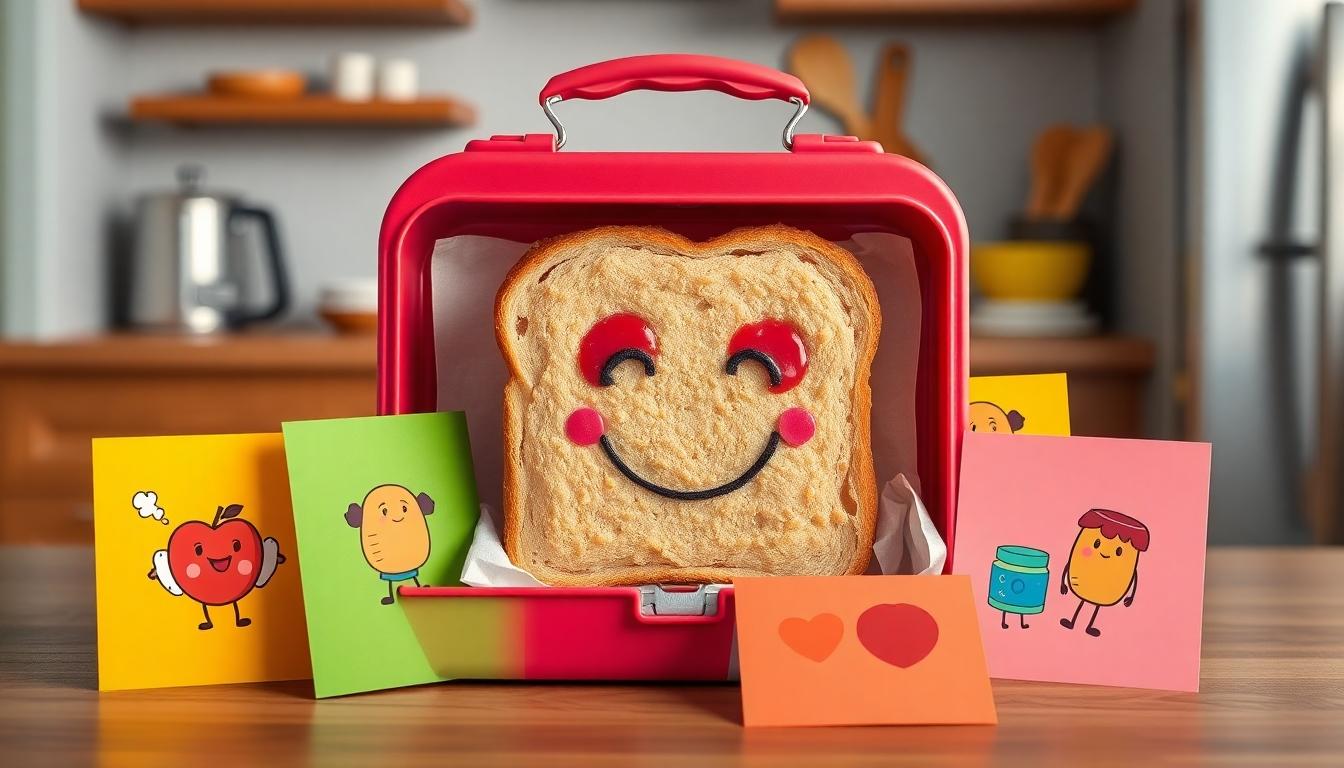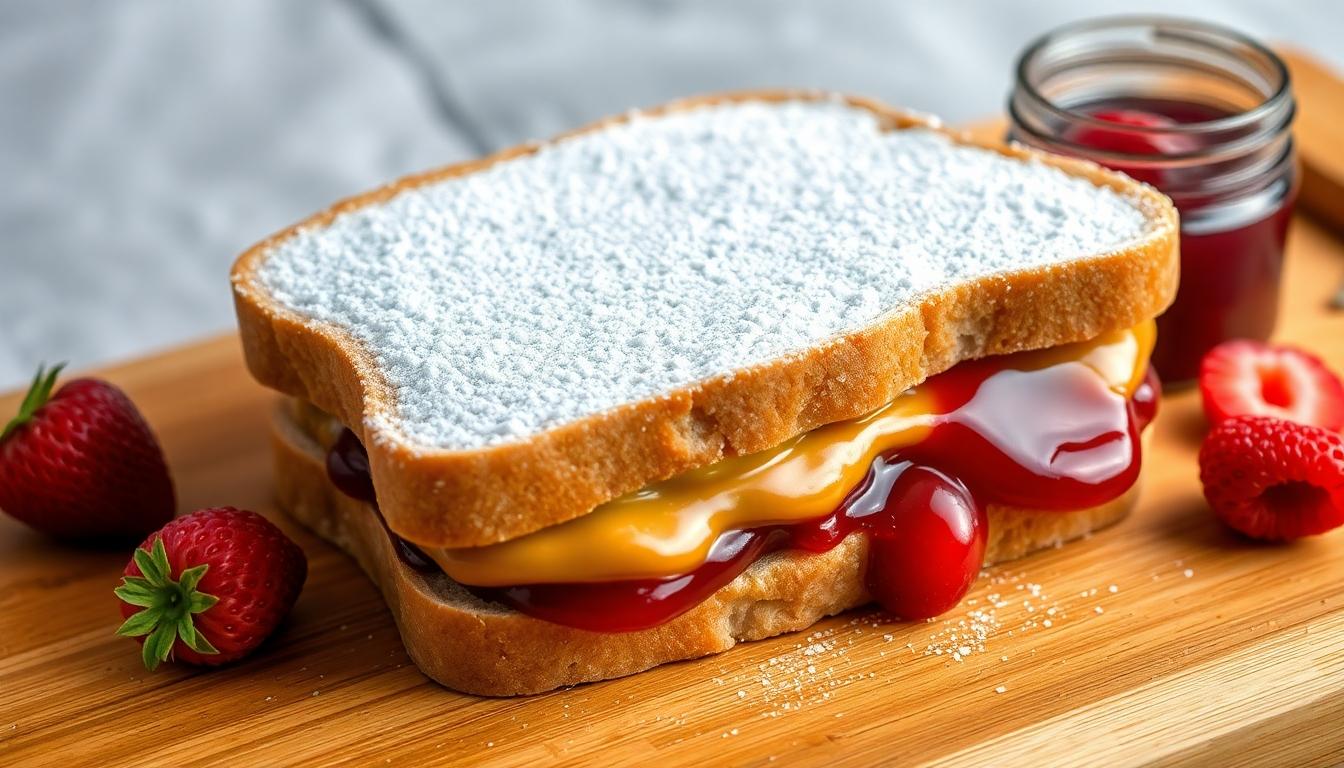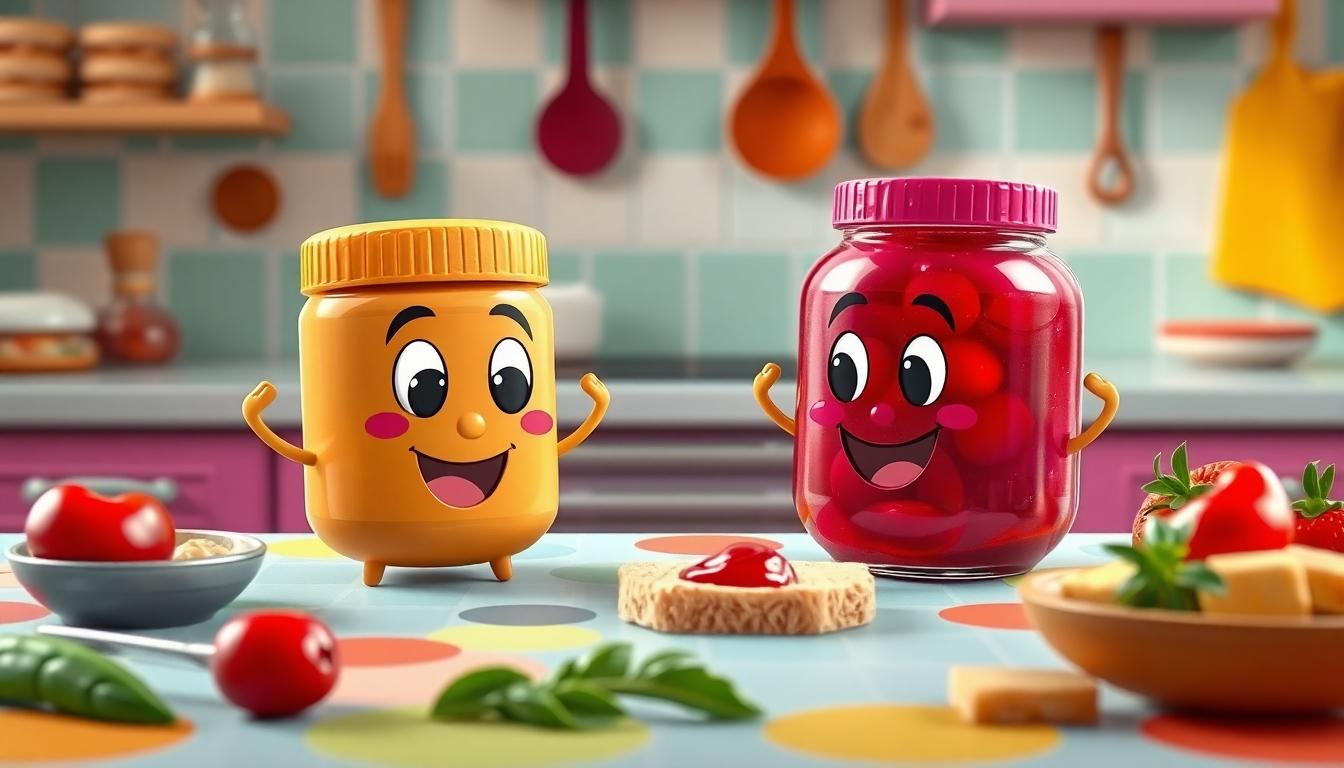Looking for some laughter with your lunch? We’ve assembled the most delicious collection of peanut butter and jelly jokes that’ll have you spreading smiles faster than grape jelly on white bread!
These punny PB&J jokes aren’t just sandwich-themed humor—they’re the perfect recipe for lightening the mood at family meals or adding some flavor to your child’s lunchbox notes. From clever wordplay to sticky situations, our handpicked selection delivers that perfect blend of nutty humor and sweet punchlines that everyone can enjoy.
10 Peanut Butter and Jelly Jokes That Will Make You Laugh
- Why did the peanut butter go to the doctor? Because it was feeling a little nutty! This classic joke never fails to crack a smile at the lunch table.
- What did the grape say when it got stepped on? Nothing, it just let out a little wine! Grape jelly enthusiasts will particularly appreciate this punny joke.
- How do you make a peanut butter and jelly sandwich dance? You spread the beat! Kids love this rhythmic play on words that combines food and music.
- Why don’t peanut butter and jelly ever break up? They go together like bread! Their sticky relationship is truly the ultimate food pairing.
- What did the jelly say to the peanut butter? “We’re on a roll!” This joke works perfectly when serving PB&J on dinner rolls instead of sliced bread.
- Why was the peanut butter jealous of the jelly? Because everyone said the jelly was jammin’! This joke plays on the musical slang term while celebrating jelly’s sweet nature.
- How does a jar of peanut butter introduce itself at parties? “Hi, I’m smooth!” Works even better with chunky peanut butter for an ironic twist.
- What do you call a peanut butter sandwich without jelly? Incomplete! Sometimes the simplest jokes get the biggest laughs from true PB&J aficionados.
- Why did the jelly go to school? To get a little bit smarter! This joke is perfect for tucking into school lunchboxes for a midday chuckle.
- What’s a sandwich’s favorite type of music? Jam! This punchline delivers a sweet finish to our collection of PB&J humor that’s sure to satisfy any appetite for food jokes.
Why PB&J Humor Is Spreading Faster Than Jelly

The Sticky Appeal of Food Puns
Food puns centered around peanut butter and jelly sandwiches have captured America’s funny bone with their delicious wordplay. These humorous quips rely on clever manipulation of terms like “jam,” “spread,” and “nutty” to create instantly relatable comedy. The beauty of PB&J humor lies in its accessibility—virtually everyone has experienced this iconic sandwich at some point in their lives. PB&J puns work so effectively because they transform everyday food vocabulary into playful expressions that evoke both recognition and laughter. Terms like “jelly-licious” and phrases encouraging people to “spread the fun” demonstrate how these food-based jokes maintain their appeal through simplicity and familiarity.
How PB&J Became America’s Favorite Sandwich Joke
The PB&J sandwich secured its place in American culture during Industry War II, creating the perfect foundation for humor that resonates across generations. Its widespread popularity stems from a winning combination of convenience, taste, and deep nostalgic connections for millions of Americans. This familiarity provides comedians and everyday joke-tellers with rich material, making PB&J references instantly recognizable in humorous contexts. The sandwich’s history dates back to the early 20th century, with the first recorded recipe appearing in a 1901 Boston culinary magazine, giving these jokes a century-long tradition to build upon. PB&J humor succeeds because it connects to shared childhood experiences while offering endless possibilities for wordplay based on the sandwich’s sticky, sweet, and sometimes messy nature.
The Best “Stuck Together” PB&J One-Liners

These deliciously sticky jokes showcase the inseparable bond between peanut butter and jelly with clever wordplay. We’ve collected some of the funniest one-liners that capture the special relationship between these sandwich soulmates.
- Why did the peanut butter break up with the jelly? It found someone a little nutty and just needed some space!
- What did the peanut say to the jelly? “You’re berry special!”
- How does peanut butter greet jelly? “Spread the love!”
- What do you call a peanut butter that can sing? A jam session!
Classic PB&J Punchlines
These timeless jokes have been making sandwich lovers laugh for generations with their smooth delivery and sweet finishes.
- Why was the peanut butter always calm? It knew how to handle sticky situations!
- Why did the jelly refuse to play hide and seek? It couldn’t find its jam!
- Why did the peanut butter go to school? To become a little smarter and spread knowledge!
Modern Twists on Traditional PB&J Humor
Today’s PB&J jokes often incorporate contemporary references while maintaining the classic elements that make these jokes so enduring. Wordplay centered around “sticky” situations remains popular in modern humor.
- “Spread the love, don’t be jelly” cleverly plays on not being jealous while referencing how these spreads work together.
- “Nut your average treat” uses smart wordplay to highlight peanut butter’s special quality.
- “Butter late than never” offers a punny take on the classic saying with a sandwich-inspired twist.
These updated jokes maintain the traditional playful interaction between peanut butter and jelly while adding contemporary elements that resonate with today’s humor preferences.
Nutty Knock-Knock Jokes Featuring Peanut Butter

Knock-knock jokes are the perfect vehicle for peanut butter humor with their simple setup and punchline format. These jokes leverage clever wordplay on terms like “peanut,” “butter,” and related sandwich concepts to create memorable laughs.
- “Knock knock!” “Who’s there?” “Peanut.” “Peanut who?” “Peanut butter and jelly, your favorite duo!”
- “Knock knock!” “Who’s there?” “Cashew.” “Cashew who?” “Cashew later, I’m busy savoring peanut butter!”
- “Knock knock!” “Who’s there?” “Butter.” “Butter who?” “Butter let me in; I’m spreading joy!”
Kid-Friendly PB&J Knock-Knocks
Kids adore these simple, wholesome knock-knock jokes that use familiar sandwich ingredients for maximum giggles. Perfect for lunchbox notes, these jokes create smiles when discovered alongside their favorite PB&J sandwich.
- “Knock knock!” “Who’s there?” “Jam.” “Jam who?” “Jammin’ with my peanut butter buddy!”
- “Knock knock!” “Who’s there?” “Toast.” “Toast who?” “Toast the peanut butter and jelly for being the best!”
- “Knock knock!” “Who’s there?” “Nut.” “Nut who?” “Nut your average sandwich, I’m PB&J!”
Many parents print these jokes on colorful cards to tuck alongside shaped sandwiches, turning an ordinary lunch into a special moment that combines food and fun.
Adult-Approved Peanut Butter Humor
While PB&J jokes often target younger audiences, adults appreciate the more sophisticated wordplay and subtle wit in these peanut butter-themed jokes.
- “What’s peanut butter’s favorite game show? ‘The Nut Price Is Right!'”
- “Why did the peanut butter go to therapy? It was having a spreading identity crisis!”
- “How does peanut butter apologize? It spreads its regrets thick!”
These jokes incorporate clever double meanings and pop-culture references while maintaining the playful essence that makes PB&J humor so universally appealing. The subtle wordplay offers a more refined take on sandwich humor that resonates with grown-ups who still enjoy the nostalgic treat.
Jelly-Related Wordplay That’s Sweet and Funny

When it comes to PB&J humor, the jelly component provides a particularly rich source of sticky situations and sweet punchlines. These jokes spread joy through clever wordplay that’s sure to preserve your good mood.
Grape Expectations: Purple Jelly Jokes
Grape jelly jokes offer a special flavor of humor that’s both punny and playful. “What did the grape jelly say at the party? ‘Let’s jam!'” perfectly captures the double meaning of “jam” as both a preserved fruit spread and a musical improvisation. Many grape jelly jokes leverage the purple spread’s reputation for being the life of the party. Grape jelly characters often appear in jokes as enthusiastic and ready to boogie, making them ideal for scenarios involving music and celebration. You’ll find these jokes particularly appealing if you enjoy wordplay that connects food with entertainment themes. The grape expectations theme continues with punchlines about “having a grape time” or being “in a jam,” showcasing how this particular flavor lends itself to multiple layers of meaning in PB&J comedy.
Strawberry Fields of Humor
Strawberry jelly jokes tend to focus on romantic themes and sweet pickup lines. “What’s a jelly’s pickup line? ‘Are you toast? I want to be on you'” demonstrates how strawberry-themed jokes often incorporate flirtatious elements. Strawberry jelly characters frequently appear as the sweeter, more romantic counterpart to nutty peanut butter personalities. These jokes typically use fruit-related metaphors that play on the berry’s reputation for sweetness and its vibrant red color. Strawberry jokes sometimes venture into “fields” of wordplay about being “the berry best” or finding your perfect “jam match.” Recent joke collections show strawberry jelly humor has remained consistently popular, likely because the bright red spread creates such a visually distinctive element in the classic sandwich. Kids particularly enjoy these jokes because they combine familiar foods with silly situations that make lunchtime more entertaining.
PB&J Jokes That Teachers and Parents Love to Share

Teachers and parents are always on the lookout for clean, kid-friendly jokes that can spark laughter in classrooms and around the dinner table. PB&J jokes offer the perfect solution with their wholesome humor and relatable subject matter. We’ve collected some of the most beloved peanut butter and jelly jokes that educators and parents enjoy sharing with children of all ages.
Sticky One-Liners
- Why did the peanut butter break up with the jelly? It found someone a little nutty! (Alternatively, because it felt smothered by the relationship.)
- What did the peanut say to the jelly? “You’re berry special!”
- Why did the jelly refuse to play hide and seek? It couldn’t find its jam!
- What did the bread say after the PB&J got together? “You two are really my jam!”
Classroom Favorites
- Why did the PB&J sandwich go to school? To become a little smarter and more well-bread!
- What’s a peanut butter’s favorite dance? The peanut butter jelly time shuffle!
- Why did the jelly get promoted? It was always on the ball!
- Why did the PB&J go to therapy? They had a lot of spread-out issues.
- Why don’t peanut butter and jelly ever get into arguments? Because they always stick together!
These delightful jokes work wonderfully in educational settings, offering teachers a fun way to engage students during snack time or as part of creative writing exercises. Parents can include them in lunchbox notes or use them to lighten the mood during mealtime. The universal appeal of PB&J humor makes these jokes accessible to children of different ages, creating moments of shared laughter that strengthen bonds between adults and kids.
The Science Behind Why PB&J Jokes Stick With Us

Overview of PB&J Jokes
PB&J jokes captivate our attention through clever wordplay, puns, and the humanization of sandwich ingredients. These jokes often take familiar concepts and spread them with humor in unexpected ways. Wordplay serves as the foundation for many PB&J jokes, like “Why did the peanut butter break up? It found someone more jelly-licious!” This type of joke brilliantly combines relationship dynamics with the texture and appeal of jelly. Puns create another layer of sticky humor, as seen in jokes such as “What did the jelly say when it won the lottery? ‘I’m on a roll, spreading my wealth.'” The double meaning of words like “roll” and “spreading” generates laughter through linguistic connections that resonate with sandwich lovers.
Psychological Factors
The remarkable stickiness of PB&J jokes comes from deep psychological foundations that make them irresistible. Relatability plays a crucial role since PB&J represents a common childhood experience for many people, triggering nostalgia and comfort when referenced in jokes. Surprise and incongruity create humor when these jokes apply serious concepts like relationships and emotions to seemingly mundane food items. The unexpected connection between everyday sandwiches and complex human situations forms the perfect recipe for memorable comedy that appeals to multiple generations.
Cognitive Processing
Our brains naturally engage with PB&J jokes through established cognitive pathways. Pattern recognition activates when we encounter these jokes because they typically follow predictable joke structures but introduce surprising twists, fully captivating our mental processes. Emotional connections form when humor combines with the familiar topic of PB&J, creating stronger memory imprints that help these jokes stick with us long after hearing them. The brain’s ability to find pleasure in recognizing patterns while being surprised by clever deviations makes PB&J humor particularly satisfying from a cognitive perspective.
How to Craft Your Own Sandwich-Inspired Humor

Master the Art of Wordplay
Creating your own PB&J jokes starts with mastering wordplay. Focus on terms related to spreads, stickiness, and sandwich-making for maximum impact. Try using puns that play on words like “spread,” “jam,” “nutty,” and “smooth” to create jokes that stick in people’s minds. For example, you might ask, “How does peanut butter greet jelly? ‘Spread the love!'” The best PB&J puns often highlight the unique properties of each ingredient while creating unexpected connections.
Personify Your Ingredients
Giving human characteristics to sandwich ingredients creates instant comedy. We recommend imagining peanut butter and jelly as characters with distinct personalities and relationship dynamics. Consider how jelly might feel “smothered” by clingy peanut butter or how peanut butter might be “smooth” in social situations. This approach works particularly well in jokes like “Why did the PB&J go to therapy? They had spread-out issues!” Anthropomorphism allows you to explore emotions and scenarios that everyone can relate to.
Leverage Contrasting Textures
The natural contrasts between peanut butter and jelly provide rich material for humor. Play with the stickiness of peanut butter versus the smoothness of jelly to create situations that highlight these differences. Jokes that explore these contrasting textures, such as “Why was peanut butter always calm? It handled sticky situations!” tend to resonate well with audiences. These contrasts create natural tension that makes for satisfying punchlines.
Incorporate Rhyming & Alliteration
Sound patterns make jokes more memorable and captivating. Use techniques like alliteration and rhyming to enhance your PB&J humor with phrases like “jam-packed,” “nutty notion,” or “well-bread.” Rhyming patterns create rhythm that makes jokes flow better, while alliteration adds a pleasing sound quality that helps jokes stick in memory. These linguistic techniques transform simple jokes into catchy one-liners that people want to share.
Create Situational Humor
Placing PB&J in unexpected scenarios generates fresh comedy angles. Imagine scenarios like peanut butter applying for jobs to “spread skills” or jelly trying to “preserve” its dignity. This approach works well for jokes like “What’s a PB&J’s favorite board game? Spreads and Ladders!” The juxtaposition of everyday sandwich ingredients in human situations creates instant humor that appeals to both children and adults.
Follow the Three-Step Formula
For consistent results, follow our proven joke-creation formula. First, identify a pun base that works with sandwich terminology (like “jam” as both music and fruit preserve). Next, personify your ingredients by giving them human motivations and feelings. Finally, add an unexpected twist that surprises the listener, such as “Why did the jelly carry a map? To avoid lost spreads!” This systematic approach helps generate jokes that maintain the classic PB&J humor style while feeling fresh and original.
The Most Popular PB&J Jokes on Social Media

Social media platforms have become a breeding ground for PB&J humor, with certain jokes consistently generating likes, shares, and comments. These viral sandwich jokes showcase creativity through wordplay and relatable food references that resonate with online audiences.
Top Viral One-Liners
PB&J one-liners dominate social feeds with their quick wit and shareable format. “Why did the peanut butter break up with the jelly? It found someone a little nutty!” stands out as a perfect example of anthropomorphic food humor with clever wordplay. “What’s a peanut butter’s favorite music? Anything with a good jam!” cleverly combines the literal meaning of fruit jam with musical slang for improvisation.
Users frequently share “Why did the jelly refuse to play hide and seek? It couldn’t find its jam!” which uses double entendre to reference both fruit preserves and being in a sticky situation. “How does peanut butter greet jelly? ‘Spread the love!'” plays on the verb “spread” while incorporating positive messaging that performs well across platforms. Another favorite that consistently generates engagement is “I tried to break up with my peanut butter, but it always sticks around,” which uses the adhesive quality of peanut butter as a metaphor for persistence.
Memes and Visual Humor
Visual PB&J jokes transform simple punchlines into shareable content through creative imagery. These memes typically pair sandwich jokes with reaction images featuring exaggerated facial expressions or sandwich-themed GIFs that amplify the comedic effect. Relationship dynamics form a common theme in these visual jokes, with scenarios like “peanut butter and jelly got married” generating substantial engagement.
Workplace humor featuring sandwich ingredients also performs exceptionally well, with jokes about “peanut butter’s smooth jazz obsession” regularly making the rounds on platforms like Instagram and Twitter. The visual component adds an extra layer of humor that plain text jokes simply can’t achieve.
Trending Themes
Certain thematic elements consistently appear in the most successful PB&J social media content. Wordplay using terms like “jam,” “spread,” and “nutty” dominates the industry, creating instantly recognizable punchlines. Personification techniques that assign human traits to ingredients (such as jelly carrying a map to avoid getting “lost in the spread”) resonate particularly well with audiences.
Music parodies represent another highly successful category, with jokes incorporating concepts like “jam sessions” or references to “smooth jazz” effectively bridging food references with pop culture. These jokes thrive because of their simplicity, universal recognition of PB&J as a comfort food, and their perfect adaptability to both text and visual formats across all major social platforms.
Why PB&J Jokes Never Go Stale: The Conclusion
PB&J jokes have truly proved they’re here to stay with their timeless appeal and universal charm. From lunchbox notes to social media memes these sticky jokes continue to spread joy across generations.
We’ve seen how these jokes work their magic through clever wordplay nostalgic connections and relatable humor. Whether you’re a teacher looking for classroom laughs a parent wanting to brighten lunchtime or simply someone who appreciates a good pun PB&J jokes offer something for everyone.
So next time you’re making that classic sandwich remember there’s more than just nutrition between those slices of bread. There’s also a serving of laughter that like the perfect PB&J never gets old!
Frequently Asked Questions
Why are peanut butter and jelly jokes so popular?
Peanut butter and jelly jokes are popular because they use relatable wordplay based on a universally recognized food. Most people have enjoyed PB&J sandwiches, creating an instant connection. The jokes tap into nostalgia while utilizing fun puns with terms like “jam,” “spread,” and “nutty.” Their accessibility makes them enjoyable for all ages, from children finding them in lunchboxes to adults appreciating the more subtle wordplay.
What makes a good peanut butter and jelly joke?
A good PB&J joke combines clever wordplay, relatability, and an element of surprise. The best jokes play on dual meanings of words like “jam,” “spread,” and “nutty,” or personify the sandwich ingredients in humorous situations. Simplicity is key—the joke should be easily understood while delivering an unexpected punchline that creates that satisfying “aha” moment that triggers laughter.
Can peanut butter and jelly jokes be educational?
Yes! Teachers often use PB&J jokes as educational tools. They help develop language skills by introducing children to wordplay, homonyms, and puns. These jokes can be incorporated into creative writing exercises, vocabulary lessons, or used as icebreakers in classroom settings. They make learning fun while helping children understand the playful nature of language and the joy of clever communication.
Are there PB&J jokes suitable for adults?
Absolutely. While many PB&J jokes appeal to children, there are plenty featuring more sophisticated wordplay and subtle wit for adults. Jokes like “Why did the peanut butter go to therapy? It was having a spreading identity crisis!” incorporate more complex concepts while maintaining the food theme. Adults often appreciate these jokes for their nostalgic value and clever linguistic tricks.
Why do PB&J jokes work well on social media?
PB&J jokes thrive on social media because they’re short, relatable, and highly shareable. They often incorporate visual elements through memes that enhance the humor. Their universal appeal crosses age groups and cultural backgrounds, making them widely engaging. Additionally, their clean, family-friendly nature makes them appropriate for all audiences, increasing their shareability and potential to go viral.
What’s the history behind PB&J jokes?
PB&J jokes gained popularity alongside the sandwich itself, which became an American staple during World War II when both peanut butter and jelly were included in soldiers’ rations. As the sandwich entered popular culture, the jokes naturally followed. The humor has evolved over decades, from simple punchlines to more complex wordplay, reflecting changing comedy styles while maintaining the core themes of this beloved food pairing.
How can parents use peanut butter and jelly jokes with kids?
Parents can write PB&J jokes on lunchbox notes to brighten their child’s day at school. They make excellent icebreakers during family meals, creating moments of shared laughter. These jokes can also turn sandwich-making into a fun activity by sharing jokes while preparing lunch. For picky eaters, the humor might even make mealtime more appealing by creating positive associations with food.
What types of PB&J jokes are most common?
The most common types include wordplay jokes using terms like “spread” and “jam,” knock-knock jokes with PB&J punchlines, personification jokes where the ingredients have human qualities, and “stuck together” jokes about the inseparable nature of the pairing. There are also specific jokes focused on grape or strawberry jelly varieties, each with their own flavor of humor.







